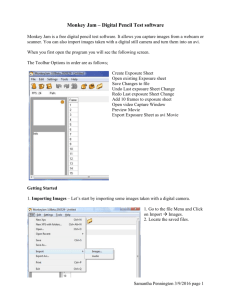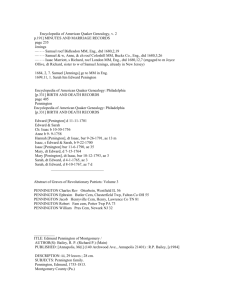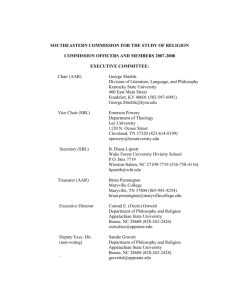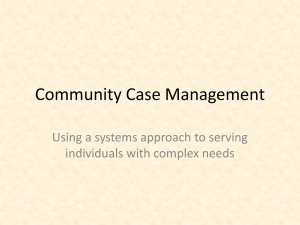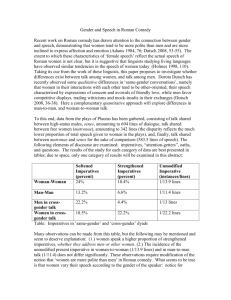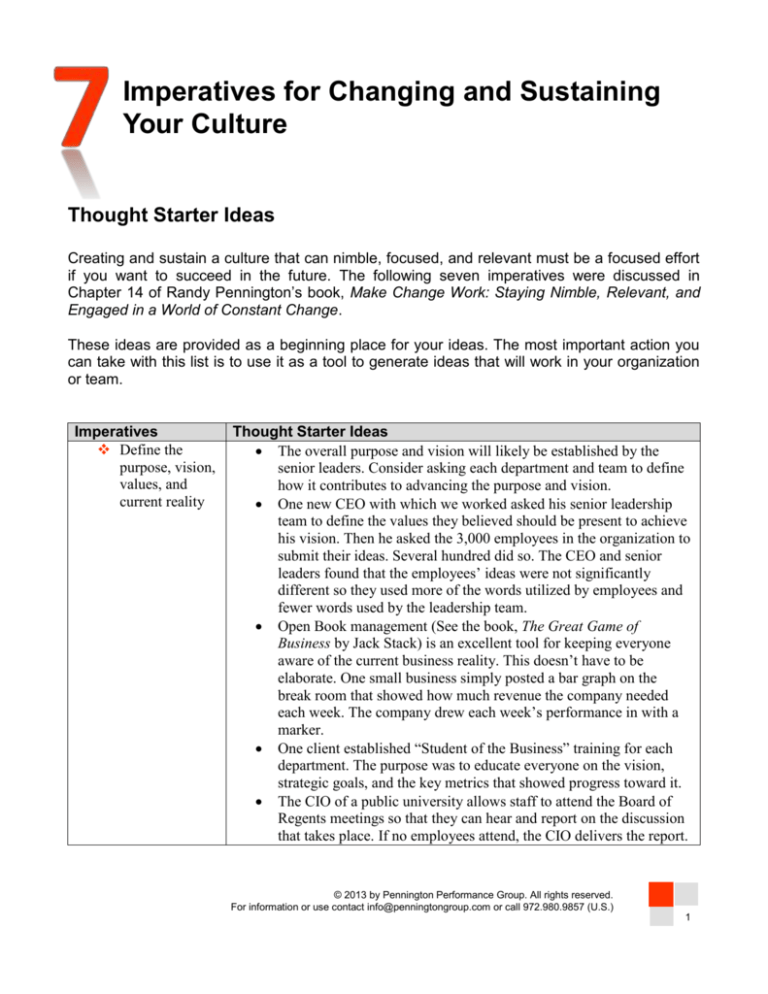
Imperatives for Changing and Sustaining
Your Culture
Thought Starter Ideas
Creating and sustain a culture that can nimble, focused, and relevant must be a focused effort
if you want to succeed in the future. The following seven imperatives were discussed in
Chapter 14 of Randy Pennington’s book, Make Change Work: Staying Nimble, Relevant, and
Engaged in a World of Constant Change.
These ideas are provided as a beginning place for your ideas. The most important action you
can take with this list is to use it as a tool to generate ideas that will work in your organization
or team.
Imperatives
Define the
purpose, vision,
values, and
current reality
Thought Starter Ideas
The overall purpose and vision will likely be established by the
senior leaders. Consider asking each department and team to define
how it contributes to advancing the purpose and vision.
One new CEO with which we worked asked his senior leadership
team to define the values they believed should be present to achieve
his vision. Then he asked the 3,000 employees in the organization to
submit their ideas. Several hundred did so. The CEO and senior
leaders found that the employees’ ideas were not significantly
different so they used more of the words utilized by employees and
fewer words used by the leadership team.
Open Book management (See the book, The Great Game of
Business by Jack Stack) is an excellent tool for keeping everyone
aware of the current business reality. This doesn’t have to be
elaborate. One small business simply posted a bar graph on the
break room that showed how much revenue the company needed
each week. The company drew each week’s performance in with a
marker.
One client established “Student of the Business” training for each
department. The purpose was to educate everyone on the vision,
strategic goals, and the key metrics that showed progress toward it.
The CIO of a public university allows staff to attend the Board of
Regents meetings so that they can hear and report on the discussion
that takes place. If no employees attend, the CIO delivers the report.
© 2013 by Pennington Performance Group. All rights reserved.
For information or use contact info@penningtongroup.com or call 972.980.9857 (U.S.)
1
Create continual
awareness
Cultivate the
language
Create a “culture committee” that is charged with keeping the
organization’s values and principles front and center with employees
Invest time in one staff meeting per month to discuss one of the
organization’s core values
Share success stories of individuals and teams who are living the
organization’s values in newsletters, in staff meetings, and on
bulletin boards
Create a “Shout Out” Wall so that peers can recognize their
colleagues who live the values and support the culture
Create a “Culture Book” so that individuals can share what the
culture means to them (Zappos does a great job at this. Check out
their videos on You Tube)
Make a big deal out of your employee survey and its results.
Encourage everyone to participate. Conduct team discussions and
focus groups to understand the data. Establish, communicate, track,
and report performance on objectives to improve survey responses.
Many organizations do an employee culture/satisfaction survey. Few
actually make a big deal about it.
Define what language supports and detracts from the culture. This is
an excellent exercise for an intact or cross functional team. Make
sure to include how to raise questions and disagree with ideas in an
appropriate manner
Develop culture specific education sessions for staff – this could be
formal training or more informal “Lunch and Learn” sessions
Create and share a glossary of terms and language to share with new
employees so that they can easily adopt the language of their new
workplace
Provide training to supervisors, managers, and teams on how to give
feedback and redirect language that is inconsistent with the culture
Include questions about cultivating and supporting the language for
staff surveys and performance reviews
Develop multiple scripts from which everyone can choose to use for
their voice mail and out-of-office email responses – developing
multiple versions allows people to choose the one that works best for
them
Create a fine jar for use in meetings when the language of the
meeting veers off course – make the amount minimal so that no one
is financially harmed and use the money for doing something for the
entire group
© 2013 by Pennington Performance Group. All rights reserved.
For information or use contact info@penningtongroup.com or call 972.980.9857 (U.S.)
2
Leverage the
legends and
symbols
Build and
maintain the
competencies
Align structure,
process,
procedure
Include living the values and promoting the culture on performance
reviews
Make supporting and promoting the culture a part of every promotion
decision
Establish rewards – peer initiated or manager initiated – for individuals
and teams who set the standard for living the culture
Talk about culture often in team meetings, newsletters, etc.
Tell stories about individuals and teams in meetings and publications
Create a “Culture Legends” book or web page to honor those who excel
at living your values
Formalize the ending of every new employee’s trial/introductory period
– at the end of the period tell the employee that you have decided that
they are a great fit for the organization and that you want them to
continue and ask them to make a conscious decision to do the same
Create a visible symbol for people who have been accepted into the
organization at the end of the trial/introductory period
Identify the specific competencies that are needed to thrive and flourish
as a representative of the culture – don’t assume that people know what
the words in your value statement mean
Build discussions and activities about what it takes to succeed in the
culture into new employee training
Offer education sessions – face-to-face or on-line – that show examples
of people living the culture
Create short culture case studies for use in staff meetings as a tool to
spur discussion and develop competencies
Conduct culture education sessions led by senior leaders to encourage
dialogue and show commitment
Systematically evaluate and align every process and procedure to
ensure that it aligns with and promotes the organization’s values
Evaluate every new process or procedure based on its alignment with
and promotion of one of the organization’s values
Examine the organization’s structure and reporting relationships on a
regular basis to ensure that it is consistent with your aspirations for the
culture – empower a team of employees to evaluate and recommend
changes to the organizational structure that would make it more
consistent with your values
Pay special attention to processes that demonstrate how you value your
staff such as performance review, career ladders, payroll processes,
corrective action/disciplinary processes, and employee recognition
© 2013 by Pennington Performance Group. All rights reserved.
For information or use contact info@penningtongroup.com or call 972.980.9857 (U.S.)
3
Actively
strengthen the
group and
assimilate
members
Assign a “buddy” to new hires in order to provide each new team
member with a resource for answering questions and ensuring that new
people have a positive role model to help them assimilate
Manage every step of the new hire process to send a message that new
people are important – provide hiring managers a checklist to ensure
that all details are addressed prior to the arrival of a new team member;
make sure team members are on hand to welcome the new person;
provide resource information to the new person about things they might
want to know such as where to park, nearby places to eat, etc.
Include sessions that are designed to teach people the culture as part of
the new employee on-boarding experience – when possible, have those
sessions led by the organization’s employees
Create a list of core questions about the organization’s values that every
candidate is asked to ensure that you are hiring for cultural fit
Conduct 360-feedback assessments about the organization’s values –
these should be used for developmental purposes rather than as part of
the performance review; you may want to begin with leaders,
managers, and supervisors and then eventually move to everyone.
Note: We strongly recommend that you be cautious in using this type
of feedback as part of the formal performance review until the culture
is ready for that level of candor.
© 2013 by Pennington Performance Group. All rights reserved.
For information or use contact info@penningtongroup.com or call 972.980.9857 (U.S.)
4


